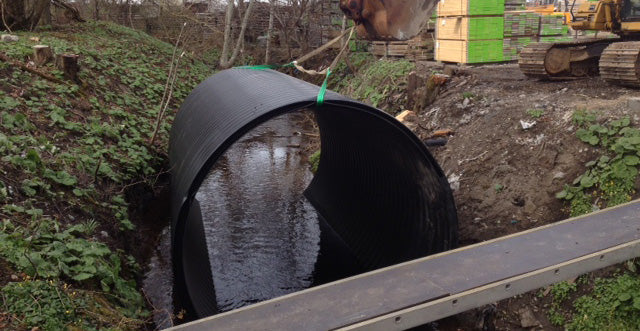If you’re planning to install a culvert pipe across a watercourse to create safe vehicle access, there are several important factors to consider before beginning your project. Below, we outline the key steps and expert tips to help ensure your culvert installation is successful and compliant.
What Is a Culvert Pipe?
A culvert is an economical and effective way of channeling a watercourse beneath a roadway, track, or pathway. It allows water to pass freely while maintaining structural integrity for vehicles or pedestrians above. Culverts are commonly used in agricultural settings to connect fields — for example, where a farm ditch is piped and covered, allowing machinery to cross safely without accessing public roads.
Culvert pipes are available in concrete, HDPE (plastic), or steel. Of these, HDPE provides major advantages: it’s lightweight for easier handling and transport, resistant to corrosion, and offers long-term durability. At Cotterill Civils, we supply culvert pipes in diameters ranging from 450 mm to 3000 mm, available in custom lengths.
Frequently Asked Questions
Top Tips on Installing a Culvert
Once you’ve chosen the right location for your culvert, start by clearing and shaping the watercourse with an excavator. Ensure it’s deep and wide enough to accommodate a pipe capable of handling maximum winter water flow without causing upstream flooding.
In some cases, temporarily diverting the watercourse can make it easier to work in dry conditions, especially if concrete or cementitious materials are required during installation.
1. Prepare a Stable Foundation
A solid foundation is essential for maintaining the alignment and durability of the culvert. The base should be level and compacted, using appropriate bedding material such as granular fill.
2. Position and Align the Pipe
Place the pipe so that it sits centrally within the watercourse and follows the natural fall of the stream. Ensure it aligns correctly with the direction of flow to avoid blockages or erosion.
3. Backfill and Stabilise
Secure the pipe with timber props, then backfill carefully around it using suitable material or concrete. Avoid using large stones or debris that could damage the pipe during compaction.
4. Construct the Headwalls
A headwall should be built at each end of the culvert to prevent erosion and stabilise the pipe inlet and outlet. Options include poured concrete, concrete blockwork, or traditional ballast-and-cement sack methods.
5. Final Checks
Once the backfill and concrete have cured, your culvert will be ready for use. Before reinstating water flow, ensure all debris is cleared and the headwalls are stable. You can then safely allow vehicles or machinery to pass over the top.
Get Expert Help
For help and advice on culvert pipes or installation best practices, contact our specialist team. Call us today on 0121 351 3230.
Alternatively, fill out our enquiry form below:





